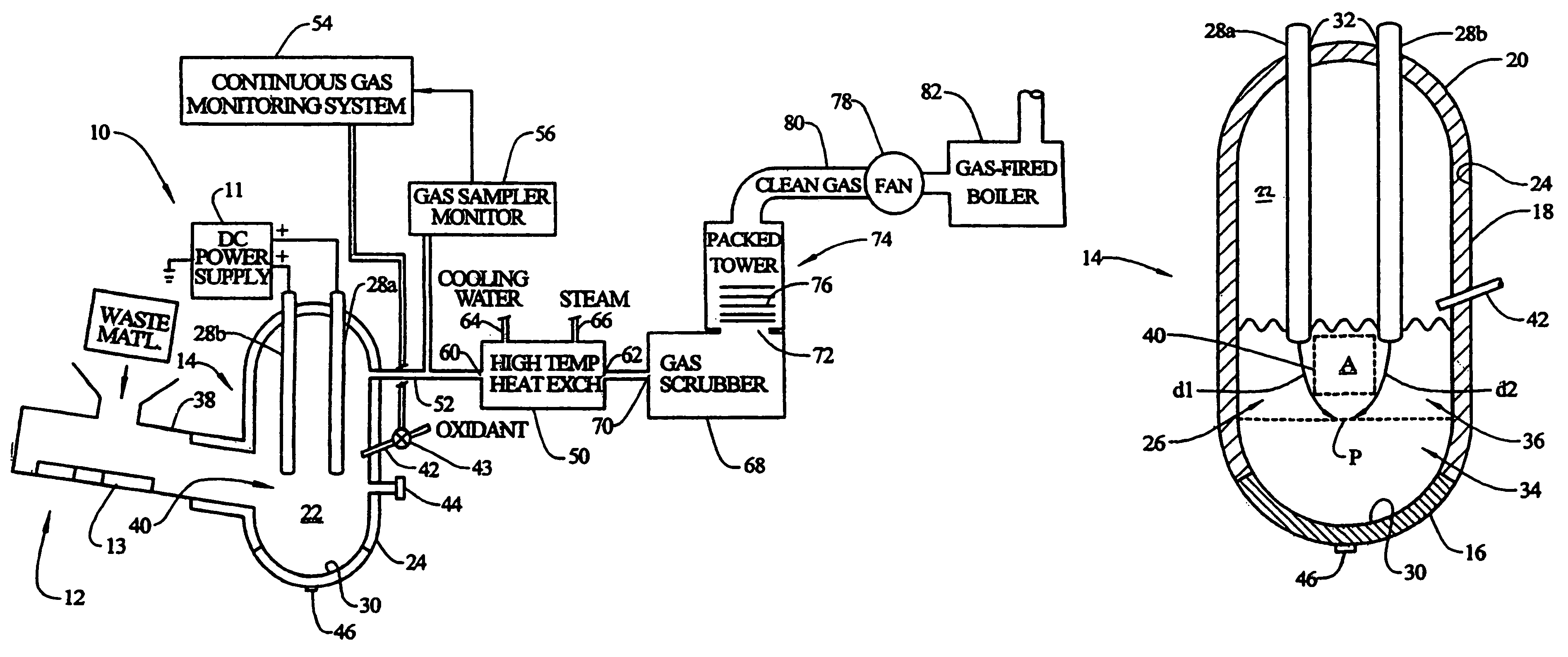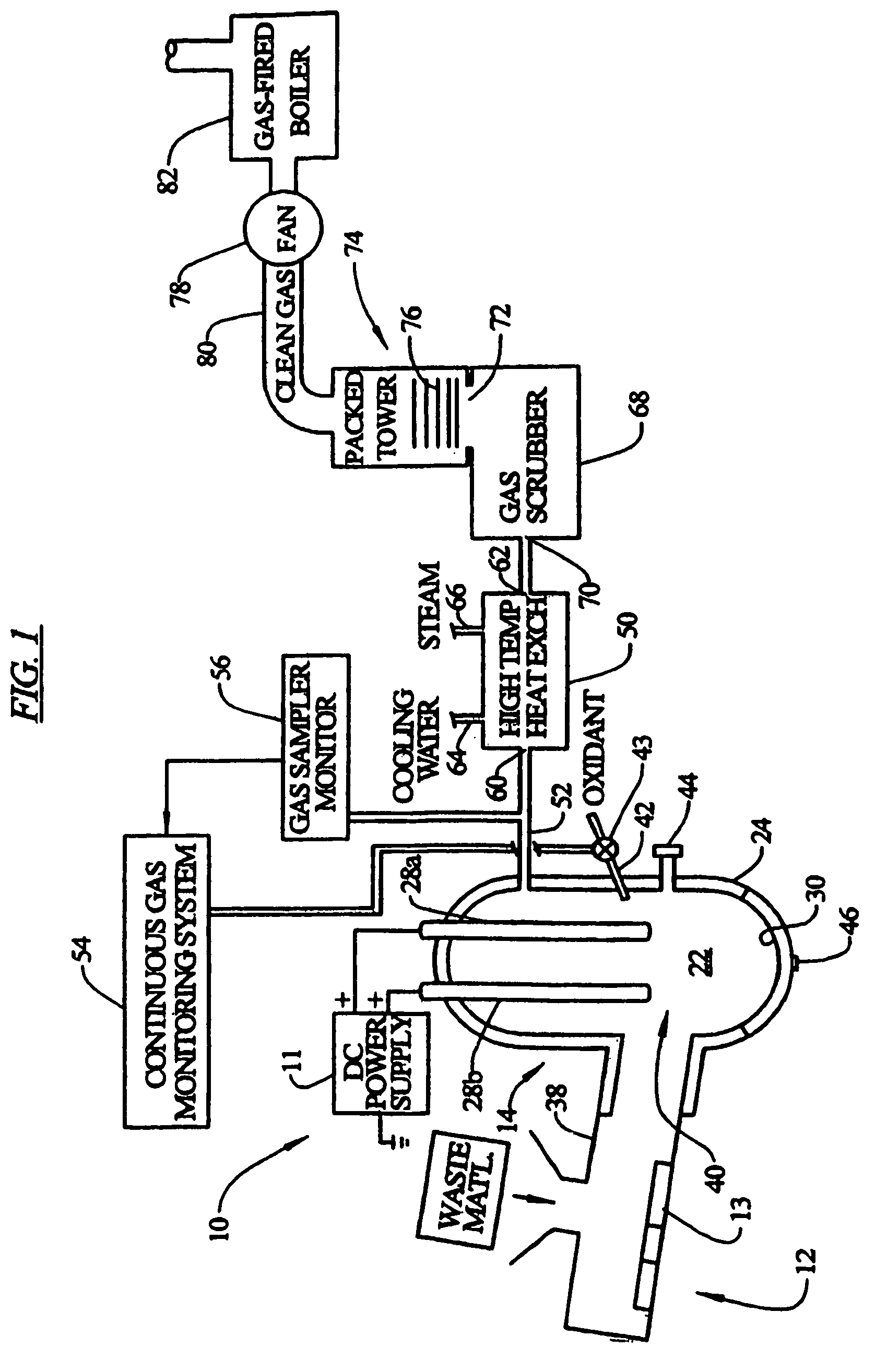Method and apparatus for plasma gasification of waste materials
a waste material and plasma gasification technology, applied in the direction of combustible gas production, lighting and heating apparatus, combustion types, etc., can solve the problems of substantial public concerns relative to land space allocation and environmental damage, the daily generation of solid waste material such as municipal solid waste and its disposal, and the inability to solve the problem of landfill sites for the disposal of such solid waste, etc., to achieve simple and inexpensive design, construction and operation
- Summary
- Abstract
- Description
- Claims
- Application Information
AI Technical Summary
Benefits of technology
Problems solved by technology
Method used
Image
Examples
second embodiment
[0056]In FIG. 5, there is shown a cross-sectional view of a refractory-lined vessel 114 of the present invention for use in the apparatus of FIG. 1. FIG. 6 is a cross-sectional view of the reactor vessel 114 of FIG. 5, taken along the lines 6-6 thereof. FIG. 7 is a cross-sectional view of the reactor vessel 114 of FIG. 5, taken along the lines 7-7 thereof. The reactor vessel 114 is substantially identical to the reactor vessel 14 of FIGS. 2 and 4, except that there is provided two feeder mechanisms and only a single anode electrode. Except for these differences, the structure and operation of the reactor vessel 114 is identical to the reactor vessel 14.
[0057]The reactor vessel 114 has the same shape and dimensions as the reactor vessel 14 illustrated in FIGS. 2-4. In particular, the reactor vessel 114 is formed by a generally semi-spherical closed bottom 116 and a circumferential side wall 118 that extends upwardly from the closed bottom 116 and terminates in a generally semi-spheri...
third embodiment
[0060]In FIG. 8, there is shown a cross-sectional view of a refractory-lined vessel 214 of the present invention for use in the apparatus of FIG. 1. FIG. 9 is a cross-sectional view of the reactor vessel 214 of FIG. 8, taken along the lines 9-9 thereof. FIG. 10 is a cross-sectional view of the reactor vessel 214 of FIG. 8, taken along the lines 10-10 thereof. The reactor vessel 214 is substantially identical to the reactor vessel 14 of FIGS. 2-4, except that there is provided two feeder mechanisms. Except for this difference, the structure and operation of the reactor vessel 214 is identical to the reactor vessel 14.
[0061]The reactor vessel 214 has the same shape and dimensions as the reactor vessel 14 illustrated in FIGS. 2-4. In particular, the reactor vessel 214 is formed by a generally semi-spherical closed bottom 216 and a circumferential side wall 218 that extends upwardly from the closed bottom 216 and terminates in a generally semi-spherical upper end 220 so as to create a p...
fourth embodiment
[0064]In FIG. 11, there is shown a cross-sectional view of a refractory-lined vessel 314 of the present invention for use in the apparatus of FIG. 1. FIG. 12 is a cross-sectional view of the reactor vessel 314 of FIG. 11, taken along the lines 12-12 thereof. FIG. 13 is a cross-sectional view of the reactor vessel 314 of FIG. 11, taken along the lines 13-13 thereof. The reactor vessel 314 is substantially identical to the reactor vessel 14 of FIGS. 2-4, except that there is provided two feeder mechanisms. Except for this difference, the structure and operation of the reactor vessel 314 is identical to the reactor vessel 14.
[0065]The reactor vessel 314 has the same shape and dimensions as the reactor vessel 14 illustrated in FIGS. 2-4. In particular, the reactor vessel 314 is formed by a generally semi-spherical closed bottom 316 and a circumferential side wall 318 which extends upwardly from the closed bottom 316 and terminates in a generally semi-spherical upper end 320 so as to cre...
PUM
| Property | Measurement | Unit |
|---|---|---|
| diameter | aaaaa | aaaaa |
| diameter | aaaaa | aaaaa |
| thickness | aaaaa | aaaaa |
Abstract
Description
Claims
Application Information
 Login to View More
Login to View More - R&D
- Intellectual Property
- Life Sciences
- Materials
- Tech Scout
- Unparalleled Data Quality
- Higher Quality Content
- 60% Fewer Hallucinations
Browse by: Latest US Patents, China's latest patents, Technical Efficacy Thesaurus, Application Domain, Technology Topic, Popular Technical Reports.
© 2025 PatSnap. All rights reserved.Legal|Privacy policy|Modern Slavery Act Transparency Statement|Sitemap|About US| Contact US: help@patsnap.com



